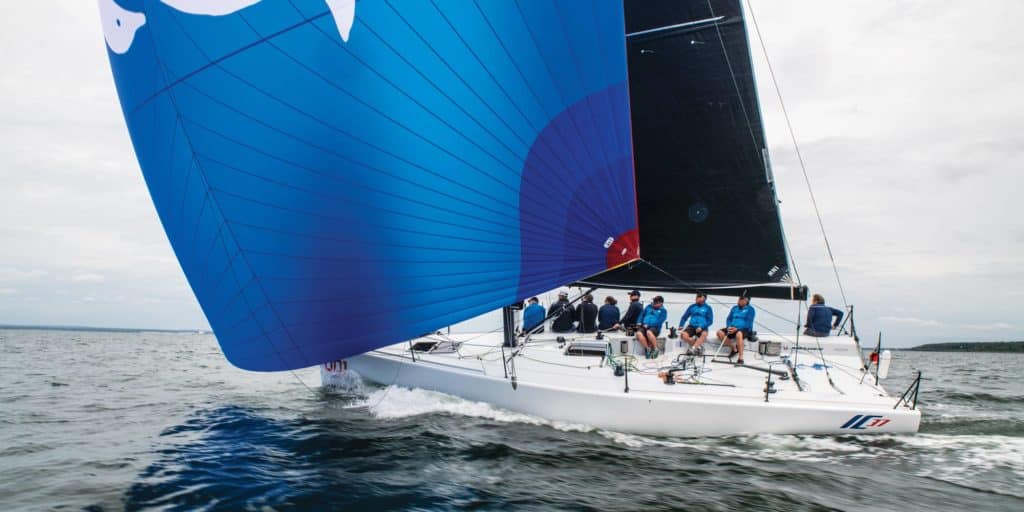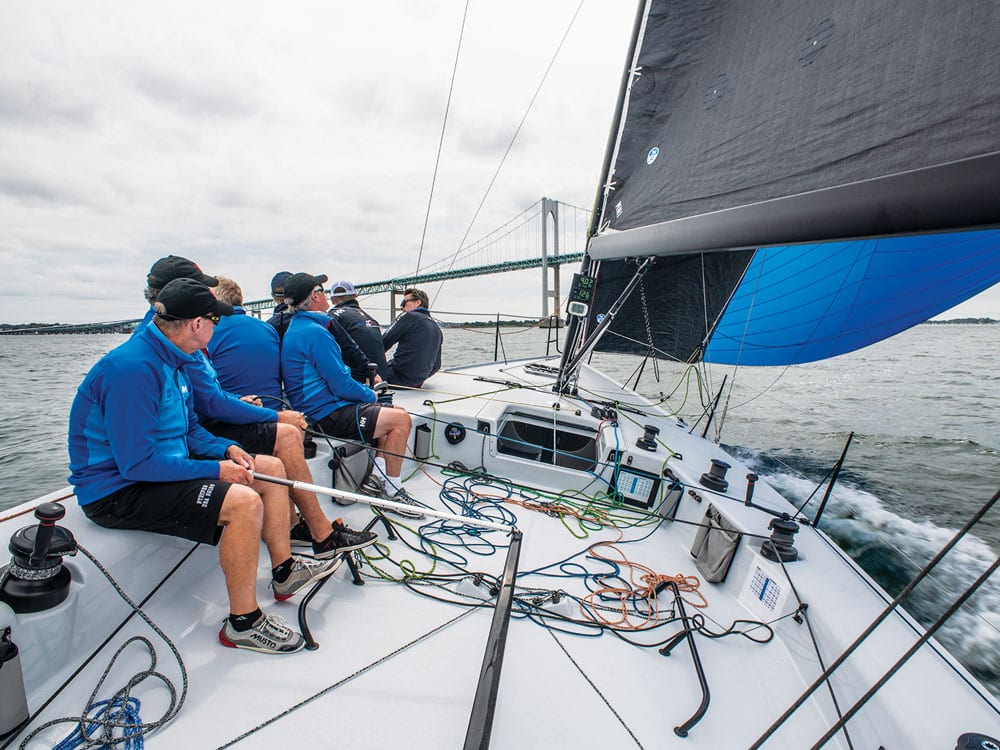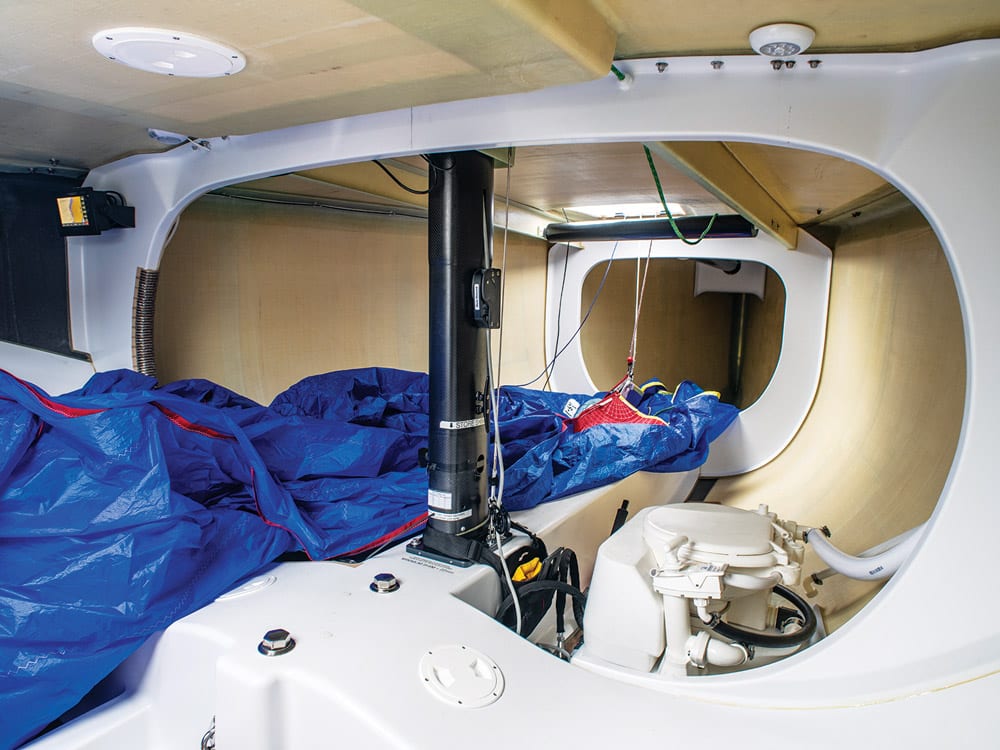
For the early years of the New York YC’s Invitational Cup, its biennial Corinthian battle of the burgees, the club relied on privately owned Club Swan 42s. Once the 42s began scattering around the world as owners sold them off, however, the club had to seek an alternative. Committee meeting after meeting eventually led flag officers to agree to bite the bullet and build a fleet from scratch.
Requests for proposals went out to a select field of designers and builders, and the committee ultimately chose a utilitarian Mark Mills design to be built by Westerly Marine in Santa Ana, California. Stakeholders were keen for an American builder and industry partnerships to keep costs in check. North Sails would build and service the three-sail class inventory, Harken got the hardware, and Melges Performance Sailboats was brought on board to sell and commission the boat and then manage the class and its promotion. Because the IC37 is designed to be raced and chartered by all-amateur crews, cost, simplicity and easy upkeep were three driving mandates. “The boat is not built to be extreme,” says Melges’ Andy Burdick. “It’s built to be fun.”
In 10 knots, the boat really gets up and goes, and is exciting to sail, he adds. “We toned down the boat for efficient crew work and sailhandling across a range of conditions.”
The IC37’s construction is your routine epoxy layup, nothing too high-tech, but certainly solid and well built, Tom Rich says. A slow start and a tight schedule to get the boats on the water and tuned for its September 2019 Invitational Cup forced the club to implement a second production line at Fibre Mechanics in England. Each builder is on the books for 10 boats apiece, with the first 20 boats going to the club. Melges’ quality-control team is monitoring weights and tolerances, and Burdick says they’ve all been close. Everything is weighed — from hull to deck and every bulkhead in between — and one-design certificates are issued at the factory.
The New York YC’s full-time fleet manager ensures the boats stay true and work with boat captains for hire. They’ll be in and out of the water a lot, and on the road as well, so there’s a single-point lift, and the keel installation requires simple tools and a bead of Sikaflex. Trailers will eventually carry boats south for a Florida winter circuit. At 7,500 pounds, a boat captain or delivery driver can simply hook it to the dually diesel and go.
The boat is beamy (12 feet), and the cockpit is big, clean and clutter-free until sheet tails start flying. Pit upkeep will be essential for clean maneuvers because foot cleats are everywhere. “It’s something they’ll have to stay on top of,” Allen says. “Someone will definitely have to be on top of cleanup between maneuvers.”

The foredeck’s job is relatively easy. With class rules mandating only one kite, one jib and one main, there will be no headsail changes, but there will be a need to master a new skill of zippering a reef into the jib in the prestart when the breeze reaches the upper end of the range. The boat’s broad-shouldered asymmetric spinnaker exits and enters from the offset foredeck hatch, with very little assistance from the bow team. That’s the beauty of its string takedown system when done right. The kite can be carried right into the mark, unloaded and out of sight in seconds. It’s a great tactical weapon. Beneath the hatch is a big roller bar and purchase to pull the kite swiftly into the bowels of the boat. No need to send anyone below to run the tapes; all bodies stay on the rail.

An experienced and strong pit person will be an asset to any team, Stewart says, because there’s plenty going on in the middle of the boat and loads are considerable. Cross-sheeting isn’t allowed under class rules, so the jib will always be trimmed at the leeward winch. Crew composition is a big consideration here, the judges note, because the boat is sensitive to weight placement, and it will certainly be faster with the trimmer included in the weather-rail stack. “You could sail with six or seven crew, but weight on the rail is good, so probably eight is ideal,” Burdick says.
At the back of the bus, the speed loop would include the main trimmer, helmsman and, ideally, a lightweight working the backstays. “Crew weight movement fore and aft and in and out is a big deal,” Chuck Allen says. “It’s a big boat, but you have to sail it like a little boat.”
And that’s how it will most likely be handled when eventually used for interclub team racing and match racing at the Canada’s Cup in 2020, the premier biennial match-race event of the Great Lakes.
Cost was a major consideration as well, especially given the financial undertaking of the club. The quoted price for the boat, with sails and basic GPS-based electronics, tops out at $340,000.
“It’s a fun boat, especially in breeze because it’s really stable. Once the teams get some time in the boats, the racing will be really close,” Allen says. “It’s pretty cool because there’s not a lot of big-boat one-design sailing in this country. There isn’t anything out there like this right now.”
Built and designed as a Corinthian-friendly one-design racer, don’t expect it to rule any handicap fleets. “This is stripped-down, big-boat one-design racing for anyone,” Burdick says. That’s what the draw to the class will be: a boat that’s about the sailing, not what you do to the boat when you’re not sailing.









